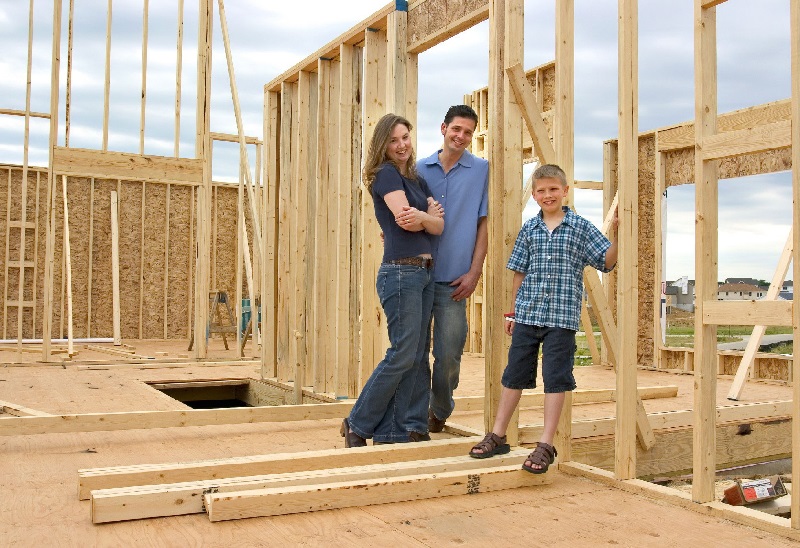Building Your Dream Home - New Construction Mortgages
Building a new home can mean a lot of great things for you and your family, including the opportunity to live in the home of your dreams; to save money compared to buying a prebuilt home; and the sense of accomplishment and satisfaction that comes with it.

However, financing the construction process can often be difficult, complicated, and time consuming, so it's not for everyone. First of all, it's important to understand your options to build your own home.
There are a Number of Ways to Get Your Dream Home Built
- Hire a Residential Home Builder - you find a new home builder, agree on a plan and budget. Either the builder already owns a lot suitable for you, or you have your own lot already. The builder gets paid by you in stages (called "draws"), and in turn pays his suppliers and tradespeople.
- Hire a General Contractor to coordinate the project for you. You supply the lot, building plans, permits, etc. The Contractor coordinates the project, suppliers and tradespeople. You pay the contractor, suppliers, and tradespeople as the construction progresses.
- Self-Build - you act as the General Contractor and hire qualified, licensed tradespeople to build the home. You must also be able to demonstrate in advance that you have the time, expertise, and industry contacts to complete the project on time*, on budget, and on spec. You will need to prove you have substantial cash resources necessary to carry the project from draw to draw.
- Pre-Built - you simply decide all the above is too much work and decide to buy a home already under construction from a builder. Typically you have some say in the finishes, appliances, etc. The builder gets paid only when you get the keys (upon completion). This is just a normal new home purchase mortgage, not a draw construction mortgage as described on this page.
In all cases in Alberta, the property must be registered and built under an approved New Home Warranty Program.
For Options 1, 2 & 3, you need a "draw or new construction mortgage"
Understanding the Process for Construction Mortgages
First of all, consider there are two parts to construction financing.
- The "draw term," which is the initial construction phase providing the borrowers with funding during the various stages of their home’s construction. The borrower pays their builder/ contractor/ trades/ suppliers from these funds. Construction mortgage rates are usually interest-only and relative to the prime lending rate, for example, 'prime plus 1%'
- The "end term" or "completion" mortgage is the second part (normal mortgage) that kicks in once the construction is 100% completed. Now you are living in the home and simply make regular mortgage payments.
Part 2 is easy. Getting started and through Part 1 can be tough.
Understanding the Draw Formula and How the Cash will Flow
During the draw term, the mortgage lender will advance money in stages based on the work that has been completed to the draw date. They will normally allow 4 or 5 draws for the borrower (you), and the draw amounts at each stage are driven by a formula based on the percentage of the project that is complete. It is important to understand:
- The bank's deal is with YOU, NOT your builder, so you need to understand how the money flows.
- You (the borrower) do NOT get money in advance to pay for things, like the building lot or supplies.
- The borrower does NOT get a dollar-for-dollar match for the money already into the project at any given point in time.
- The available draw schedule is NOT negotiable: it is determined in advance by mortgage lending rules as part of the approval process, and depends on things like whether the loan is a CMHC construction mortgage (insured / low down payment), who owns the lot, and your down payment. (See 'Advances' table as example)
- The borrower must prove arrangements are in place at the outset (mortgage approval time) to make up any cash and timing differences between what money the draw schedule will provide you and what your builder/contractor/trades/suppliers require to start (or continue) working on your project.
- A worksheet / budget showing projected cash and timing requirements is invaluable to illustrate when the money is coming in and when it is going out, and to whom. Ask us if you need a template of want to understand the cash flows in more detail
Don't Run Out of Money!
So, as part of the mortgage approval process, the borrower must prove that no-one is going to run out of money between draws. Everyone needs to know how the cash will flow before you even get started.
We are here to help you understand and plan your new home build financing, and to get you pre-approved and underway! Please give us a call.


.jpg)